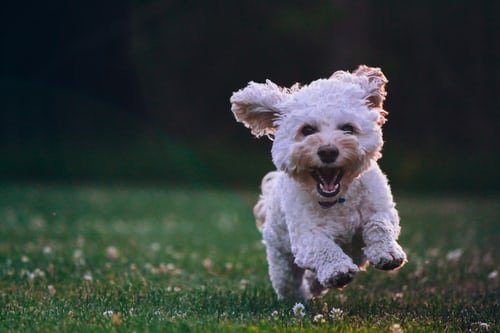
In one of the dog handlers' groups, I opened the debate about this type of training. As in everything, there were detractors and admirers of this methodology, but above all there were many doubts about its basis and how to put positive dog training into practice.
Remember how happy you felt when you saw your parents proud of you for every A you got? It made you want to do it again, didn't it? Well, that's positive reinforcement.
Dogs care about praise, play and food. The main tool for changing a dog's behaviour over the course of a dog's lifetime is training or education. This is something that those of us who love and study dogs have always thought, but it is true that until now, there has been no scientific evidence of this. I believe that like everything else in life, dog training should be easy and based on the evidence of dog behaviour and common sense.
In my social networks I have made a post in relation to the research on the impact of pre-adolescent training on canine behaviour. Below is the reference and the link to access the study.
REFERENCE:DINWOODIE, I.R.;ZOTTOLA, V.; V.; DODMAN, N.H. AN INVESTIGATION INTO THE IMPACT OF PRE-ADOLESCENT TRAINING ON CANINE BEHAVIOUR. ANIMALS 2021, 11, 1298. HTTS://DOI.ORG/10.3390/ANI11051298
https://www.mdpi.com/2076-2615/11/5/1298#

🎁 Rewarding a dog for good behaviour sounds simple and rewarding enough, and it is. Much more so than forcing him to do the required actions as some trainers who continue with traditional techniques do.
But to practise this technique effectively, some basic guidelines must be followed. Even if our furry friend wins what he likes, he cannot have the freedom to do whatever he wants, but it is necessary to set limits on what he should and should not do.
We will start by getting to know what the reinforcement technique consists of, what positive reinforcement is, what positive reinforcement training is and how it is applied.
What is reinforcement and positive reinforcement?
By Reinforcement means the action of adding elements. Positive reinforcement is therefore the addition of a reward if the dog's desired response is obtained.
Positive reinforcement in positive dog training is one of the most powerful tools for shaping or changing a dog's behaviour because the reward makes it more likely that the rewarded behaviour will be repeated.
What is negative reinforcement?
There is also the negative reinforcement, which consists in removing an annoying or unpleasant stimulus. when the dog performs an appropriate behaviour. This technique is not recommended as it can lead to unwanted or harmful behaviour in the dog.
What is positive training or positive reinforcement training?
In dog training there are techniques based on learning theories. and techniques based on canine ethology. Learning theories state a link between the stimulus that has been conditioned by the handler and a stimulus produced by the dogso that the former is used to achieve the latter.
The Positive dog training se ha instaurado en España hace años y ya lleva mucho tiempo consolidada en el resto del mundo. El Reino Unido, dónde yo resido, es uno de los países pioneros y con mayor concienciación y respeto por los animales que conozco.
Positive training is based on respect for the dog, putting the dog's welfare before the training objectives. Techniques based on learning theories are used using a reward (treats, praise, toys, anything the dog finds rewarding) to encourage desired behaviours.
As we have already mentioned, in order to practise this type of training effectively, some basic guidelines must be followed and limits must be set as to what the dog should and should not do.

How to apply positive training?
Timing is everything
Correct timing is essential when using positive reinforcement. The reward must occur immediately (within seconds) or your dog may not associate it with the appropriate action. For example, if you make your dog sit, but reward him after he has stood up, he will think he is being rewarded for standing.
Be brief
Dogs do not understand sentences. If you say "Nala, I want you to be good and sit", he will probably stare blankly. In fact, dogs first learn from our body language, so work on enticing your dog to sit or lie down before you ask him to do so with a word. Once he has learned the behaviour systematically, start adding the word "sit" or "down", but try not to repeat it and say it in a calm voice. Keep commands short and uncomplicated. The word "No" used for correction is considered positive punishment and would not be part of positive training.
Most used orders
Watch (eyes on me or look at me)
Sit (sit down)
Stay (to stand still).
Down or (plas)
Off (get off me, someone else or the furniture)
Up or (get up)
Come
Heel (walk near me or close to me)
Leave it (don't touch or pick up anything from the floor or leave it)
Consistency is key
All members of the family should use the same commands, otherwise the dog may become confused. It may be useful to publish a list of commands where the whole family can familiarise themselves with them.
Consistency also means always rewarding desired behaviour and never rewarding undesired behaviour.
When to use positive reinforcement in positive education
The results of this training are obtained in a very quick and reliable waymaking the dog relate by himself the exercises and what the handler expects from him, which strengthens the bond between them.
The good thing about positive reinforcement
Positive reinforcement is great for teaching your dog commands and is also a good way to reinforce good behaviour. You can make your dog sit before:
- Letting him go outside (which helps prevent him from lunging at the door).
- Stroke him (to prevent him from jumping on people).
- Feeding (which helps to teach good mealtime manners)
Give him a pet, tell him "good dog" for staying still at your feet, or slip a treat in a Kong® type toy. .
The downside of positive reinforcement
We must be careful not to inadvertently use positive reinforcement to reward unwanted behaviour. For example, if you let your dog out every time he barks at a noise in the neighbourhood, you are rewarding (access to the garden) a behaviour you do not want.
Shaping dog behaviour
Your dog may take time to learn certain behaviours. There is a technique called "shaping", which involves reinforcing something close to the desired response and gradually demanding more from your dog before he receives a reward.
For example, if you are teaching your dog to "shake hands", you can reward him initially for lifting a paw off the ground, then for lifting it higher, then for touching your hand, then for letting you hold his paw, and finally for "shaking your hand".
Types of reward
Positive reinforcement can include treats, praise, petting or a favourite toy or game. Since most dogs are highly motivated by food, treats work especially well for training.
Use treats that you know your dog likes and have variety so he doesn't get bored. It should be a very small piece of food (the size of a pea or even smaller for small dogs) and soft, so he will gobble it up immediately and look for more. Don't give the dog anything that he has to chew or break into pieces and fall on the floor.
Whenever you use a food reward, you should also praise him. Say something like "yes" or "good dog" in an enthusiastic tone of voice and then give him his treat.
If your dog is not interested in treats you can use a toy, a cuddle or a short game as very effective rewards.
When to give sweets
When your dog is learning a new behaviour, reward him each time he demonstrates it. This is called continuous reinforcement.
Once your dog has reliably learned the behaviour, you should switch to intermittent reinforcement, where you continue to praise, but gradually reduce the number of times he receives a treat for performing the desired behaviour.
At first, reward with a treat four out of every five times he performs the behaviour. Over time, reward three out of five times, and so on, until you only reward occasionally. But don't decrease rewards too quickly so he doesn't get frustrated or confused. Keep praising every time he does what is expected and once he has learned the behaviour you can reduce the intensity of the rewards.
Use a variable reinforcement schedule so he doesn't realise that he only has to respond every other time. The dog will soon learn that if he keeps responding, he will get what he wants - your praise and an occasional treat. By understanding positive reinforcement, you will see that you are not obliged to carry a pocketful of treats at all times. Your dog will soon strive for your verbal praise, because he wants to please you and knows that he'll get a treat from time to time, too.
Is punishment always harmful?
The use of punishment is an unpleasant technique for any animal and can destroy the bond between handler and dog by increasing the dog's stress and anxiety levels.
We have all been wrong at times with our dogs and we should not blame ourselves for it. The problem is that we believe that apparently it works and when we incorporate it as a routine, we are not aware of the consequences that it can have, such as fear, anxiety, stress, blocking, learned helplessness, etc. This is called positive punishmentwhere the handler applies a punishment, in the form of a blow or a tug on the lead, with the intention of preventing the dog from repeating a behaviour it has performed. This technique is not part of positive training, and as mentioned above, can be counterproductive for both parties.
However, the punishment may involve may involve only the withdrawal of a pleasant stimulus for the dog as a consequence of inappropriate or unwanted behaviour. This is known as negative punishment.. Positive reinforcement combined with negative punishment.has beneficial results for our furry friends. For example, if the dog does an undesired action, we do not reward him with a treat, a toy or our petting because we do not want him to repeat it.
Conclusion on positive training
Everything that is done out of love for dogs cannot go wrong. Dog training does not consist of an exclusive technique, but requires a hybrid of different exercises in order to obtain the desired results. It requires a lot of love for the dog, patience, time, consistency and constancy.
Positive reinforcement techniques increase the dog's behaviour in a way that is beneficial for them and their families. Therefore, combined with other techniques such as negative punishment, very good and long-lasting results can be obtained.
And as always, if you are interested, here are a couple of very interesting canine books that I hope you enjoy:
- The essential guide to raising your dog with respect for the environment. Enric in positive, the most watched dog training channel in Spain. It is a guide to training your dog, or correcting behavioural problems without having to resort to fear and pain based methods, In "Adiestra en positivo"Enric Rodríguez offers basic notions about canine psychology, tips to avoid bad behaviour, and tricks and skills to teach them with love.
- On Talking Terms with Dogs: Calming Signals Based on the author Turid Rugaas' own experiences, the author discovers the keys to dog language that will allow us to communicate more directly and effectively with our pets.
Here you can have a look at other dog training books.


